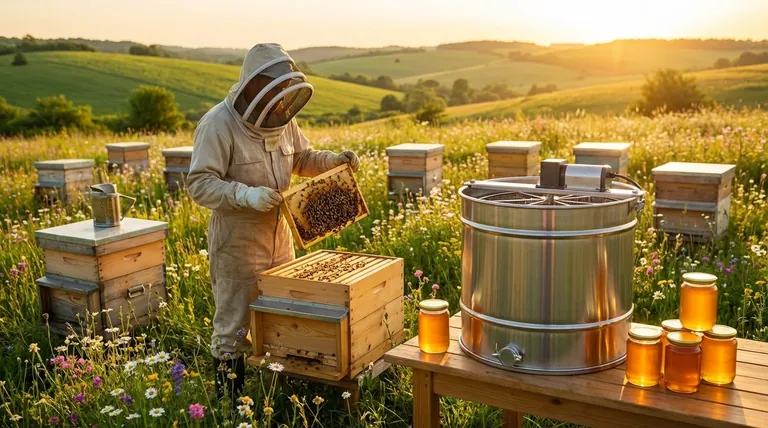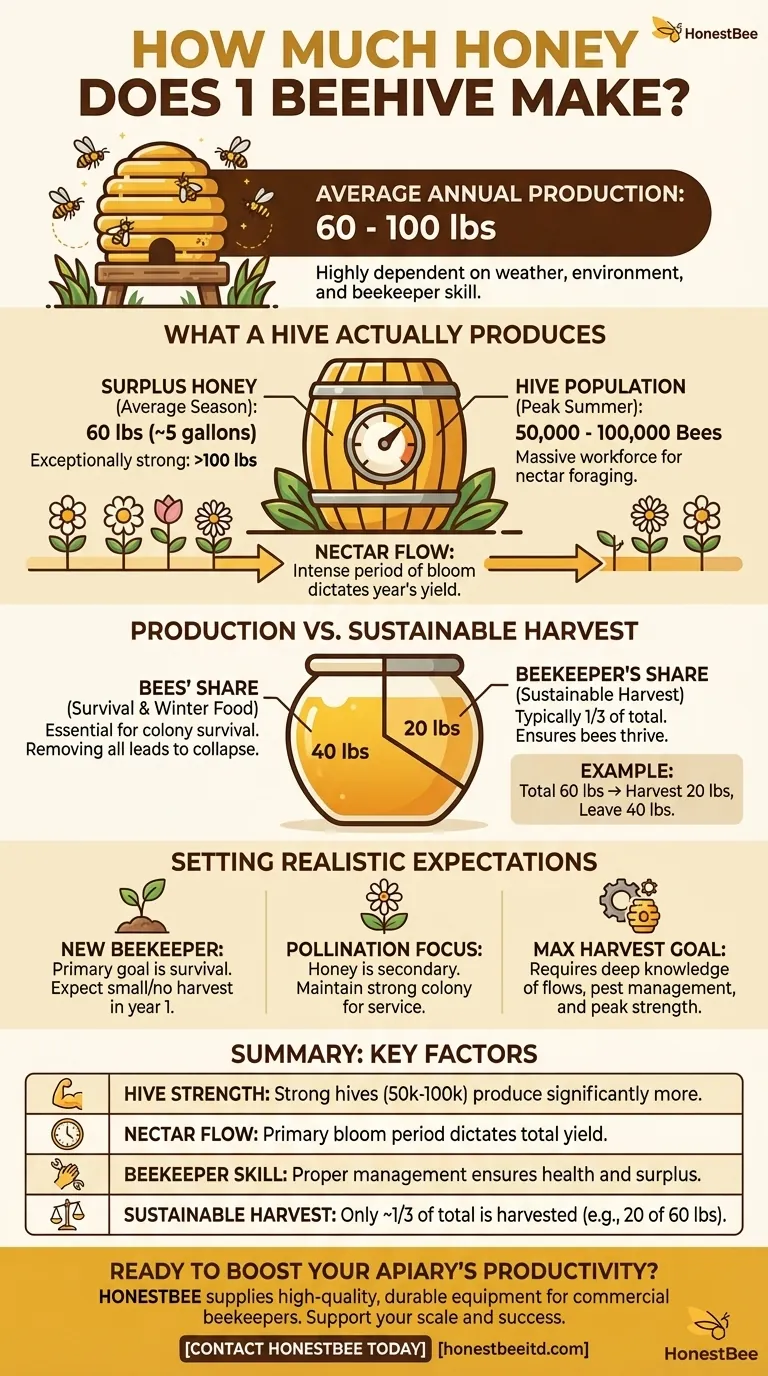On average, a single healthy beehive can produce 60 to 100 pounds of honey per year. This figure, however, is not a guarantee. The final amount is highly dependent on factors like weather, local environment, and the skill of the beekeeper.
The most critical concept to understand is the difference between total production and sustainable harvest. A hive's full output is for its own survival; a beekeeper's harvest is only the true surplus that the colony can spare.

What a Hive Actually Produces
A beehive is a complex biological engine. Its honey output is a direct result of its population, health, and the resources available in its environment during a critical window of time.
The Average Production Range
A mature, strong hive will typically produce around 60 pounds (about 5 gallons) of surplus honey in a season. Exceptionally strong hives in ideal conditions can produce over 100 pounds.
Hive Population is Key
During the peak of summer, a powerful hive can house between 50,000 and 100,000 bees. This massive workforce is required to forage for nectar and convert it into the large stores of honey needed for the colony.
The Importance of the "Nectar Flow"
Honey isn't made steadily throughout the year. The bulk of production happens during a period known as the nectar flow, when local flowers are in full bloom. This is an intense period of work that dictates the year's entire honey yield.
Understanding the Trade-offs: Production vs. Harvest
Many are surprised to learn that a beekeeper does not—and should not—take all the honey a hive produces. This distinction is fundamental to responsible beekeeping.
Why Bees Need Their Honey
Honey is the bees' food source, providing the carbohydrates they need to survive the winter and fuel their activities. Removing all of their stores would lead to the starvation and collapse of the colony.
The Beekeeper's Share
A common and sustainable practice is for a beekeeper to harvest only about one-third of the honey from the hive. This ensures the bees have more than enough to thrive.
A Practical Example
If a hive produces 60 pounds of honey, a beekeeper will harvest approximately 20 pounds. The remaining 40 pounds are left for the bees as their essential winter food supply.
Setting Realistic Expectations for Your Hive
The amount of honey you can expect is directly tied to your specific goals and local conditions.
- If you are a new beekeeper: Your primary goal is colony survival, so expect a much smaller harvest, if any, in the first year as the bees build their home and population.
- If your primary focus is pollination: The honey harvest is a secondary benefit; focus on maintaining a strong, healthy colony to service local plants and crops.
- If your goal is maximum honey harvest: Success requires a deep understanding of local nectar flows, proactive pest management, and ensuring the colony is always at peak strength before the bloom.
Ultimately, the yield from a beehive is a direct reflection of the health of the colony and its surrounding ecosystem.
Summary Table:
| Key Factor | Impact on Honey Production |
|---|---|
| Hive Strength | Strong hives (50k-100k bees) produce significantly more. |
| Nectar Flow | The primary bloom period dictates the year's total yield. |
| Beekeeper Skill | Proper management ensures a healthy colony and surplus honey. |
| Sustainable Harvest | Typically only 1/3 of total production is harvested (e.g., 20 lbs from 60 lbs). |
Ready to boost your apiary's productivity and honey yields?
As a commercial beekeeper or distributor, maximizing hive health and efficiency is your business. HONESTBEE supplies the high-quality, durable beekeeping supplies and equipment you need to build strong colonies and capitalize on every nectar flow.
From essential hive components to protective gear and extraction tools, our wholesale-focused operations are designed to support your scale and success.
Contact HONESTBEE today to discuss your equipment needs and get a quote tailored for commercial operations.
Visual Guide

Related Products
- HONESTBEE 72 Frame Industrial Electric Honey Extractor for Beekeeping
- 2 Frame Stainless Steel Manual Honey Spinner Extractor for Beekeeping
- HONESTBEE 3-Frame Manual Acrylic Honey Extractor
- electric honey extractor honey centrifuge 3 frame honey extractor stainless steel honey frame extractor
- 40 Frame Commercial Electric Honey Extractor for Beekeeping
People Also Ask
- How do automatic honey extractors function? Achieve High-Efficiency Honey Harvesting
- What are the advantages of automated honey extractors in terms of time efficiency? Boost Your Harvest Speed
- How is honey harvested from Langstroth hives? A Guide to Efficient, Comb-Preserving Extraction
- What are the two common types of honey extractors? Choose the Right Extractor for Your Apiary
- Why is preserving honeycomb integrity important, and how do automated extractors help? Boost Hive Health & Honey Yields



















